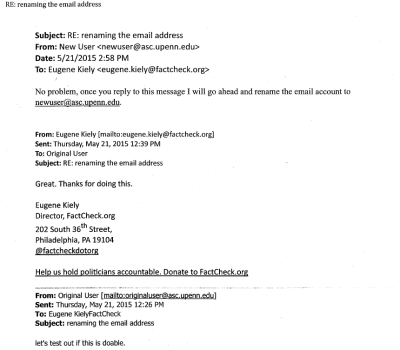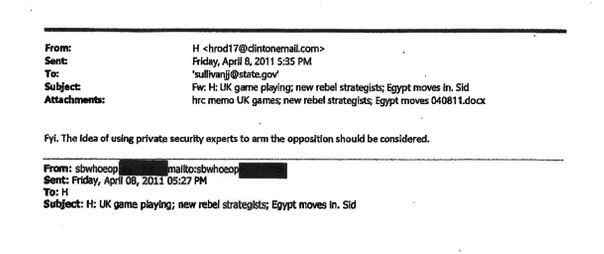The Republican National Committee thinks it has the smoking gun that proves Hillary Clinton used “multiple secret email addresses” as secretary of state. It doesn’t.
The RNC made its claim in a May 18 blog post hours after the New York Times published copies of emails that Clinton had sent and received when she was secretary. The emails displayed two accounts: hdr22@clintonemail.com and hrod17@clintonemail.com. That seemed to clearly contradict Clinton’s claim that she used only hdr22@clintonemail.com while in office, which was from January 2009 to February 2013.
But the Clinton campaign says there is a simple explanation for this apparent discrepancy: The emails published by the Times were printed out in 2014 after Clinton had left the State Department and after she had changed her email address, so the printed copies of emails she sent while in office display her new address (hrod17@clintonemail.com), even though they were originally sent under her old address (hdr22@clintonemail.com). We agree that this is possible.
The Clinton explanation passed two tests — including one conducted for us by Ray Tomlinson, the man who is widely credited with inventing email.
Tomlinson ran an optical character recognition on the PDF of the emails that the Times posted to its website, and what he found is consistent with the Clinton campaign’s explanation for what happened.
We at FactCheck.org also tested Clinton’s explanation. Our IT staff created originaluser@asc.upenn.edu and renamed it newuser@asc.upenn.edu. An email sent by originaluser@asc.upenn.edu printed out as if it had come from newuser@asc.upenn.edu after we changed the name of the email account.
Tom Conte, a professor at the Schools of Electrical & Computer Engineering and Computer Science at Georgia Institute of Technology and president of the IEEE Computer Society, said Clinton’s explanation is “technically possible” and that our test “proves it.”
@clintonemail.com
As most know by now, Clinton did not use the government email system while secretary of state. Instead, she used a private server and email account. This unusual arrangement — first detailed March 2 by the New York Times — triggered a political firestorm.
Republicans have accused Clinton of seeking to avoid public disclosure of her emails on controversial issues, such as the Sept. 11, 2012, attack on the temporary consulate in Benghazi that resulted in the deaths of four Americans, including U.S. Ambassador to Libya Chris Stevens. For her part, Clinton has said that her email arrangements were a matter of convenience, and that the “vast majority of my work emails went to government employees at their government addresses,” so they were preserved at the State Department.
The issue of how many private email accounts Clinton used was first raised by a special House committee investigating Benghazi.
On March 4, two days after the Times disclosed Clinton’s exclusive use of personal emails to conduct official business, the Select Committee on Benghazi said it was “in possession of records with two separate and distinct email addresses used by former Secretary Clinton and dated during the time she was Secretary of State.” At the time, the House committee declined our request to provide us with the second email address.
Why does it matter how many private email accounts Clinton had? The Republicans question whether Clinton has been forthcoming in turning over all the documents related to Benghazi. Clinton turned over 55,000 pages of emails to the State Department in December 2014, her office confirmed after the Times story appeared.
The existence of hdr22@clintonemail.com has been public knowledge since March 2013, a month after she left office. But the existence of hrod17@clintonemail.com became public when the New York Times on May 18 and May 21 published copies of the printed emails.
On May 18, the RNC wrote that the emails published by the Times contradicted a claim by Clinton’s lawyer that she used only one @clintonemail.com email account as secretary of state. Clinton’s lawyer David Kendall sent a letter on March 27 to Rep. Trey Gowdy, the chairman of the Benghazi committee, that said “ ‘hrod17@clintonemail.com’ is not an address that existed during Secretary Clinton’s tenure as Secretary of State.”
On May 20, House Speaker John Boehner’s spokesman Matt Wolking wrote that Kendall’s response to the committee is “completely false.” He wrote, “The address hrod17@clintonemail.com did exist while she was Secretary of State, according to emails from 2011 and 2012 published by The New York Times on Monday.”
Conservative websites were abuzz with claims that Clinton was “caught in another email lie,” as Breitbart put it.
The Blaze embedded several emails (like the one below) into its news article and said, “Multiple emails show Clinton used account “hrod17@clintonemail.com” while serving in the Obama administration as secretary of state.”
But all is not what it seems.
What the Evidence Shows and Experts Say
When we contacted the Clinton campaign about the apparent discrepancy, we were referred to an explanation that was first contained in a Q&A issued by the campaign on March 10. The question and answer addressed the allegation, made by the Benghazi committee, that Clinton had two private email addresses:
Why did the Select Committee announce that she used multiple email addresses during her tenure?
In fairness to the Committee, this was an honest misunderstanding. Secretary Clinton used one email account during her tenure at State (with the exception of her first weeks in office while transitioning from an email account she had previously used). In March 2013, a month after she left the Department, Gawker published the email address she used while Secretary, and so she had to change the address on her account.
At the time the printed copies were provided to the Department last year, because it was the same account, the new email address established after she left office appeared on the printed copies as the sender, and not the address she used as Secretary. In fact, this address on the account did not exist until March 2013. This led to understandable confusion that was cleared up directly with the Committee after its press conference.
Kendall, in his letter to the committee, identified the new email address established in March 2013 as hrod17@clintonemail.com.
But why would the emails — including the one we display above — show hrod17@clintonemail.com as the sender if it came from hdr22@clintonemail.com? Is that even technically possible?
We consulted four computer experts, and all agreed that it was possible. There is one example in the trove of emails that the Times posted online that proves it is possible. That’s a May 6, 2011, email from Clinton to Jake Sullivan, who at the time was her deputy chief of staff and director of policy planning.
On page 31 of the New York Times‘ PDF of Clinton’s emails is a print copy of Clinton’s email to Sullivan that shows Clinton’s email address as hrod17@clintonemail.com (the one she says was created after she left office). But that same email also appears on page 35 of the PDF as part of an email exchange with Sullivan (who had responded to her), and the email address for Clinton in that case is displayed as hdr22@clintonemail.com.
“This string of email messages proves the Clinton team’s explanation is true,” said Conte, the president of the IEEE Computer Society.
The reason, he said, is simple: The hdr22@clintonemail.com address that is part of the email string is now static text, so it wouldn’t change. That means that the email originated from hdr22@clintonemail.com. But the address on the printed version of just Clinton’s email to Sullivan would be populated with the new email address because that is an active data field — giving the illusion that it came from hrod17@clintonemail.com.
We asked our IT staffers to see if they could recreate the same behavior, and they did. They created an email account called originaluser@asc.upenn.edu, exchanged emails with this author and then changed the name of the account to newuser@asc.upenn.edu. The emails were then printed out by the sender after the account was renamed. The results are below.
The first email sent on Thursday, May 21, at 12:26 p.m. displays originaluser@asc.upenn.edu as the sender, because it was part of an email string and was static text:
 But that same email appeared to be sent from newuser@asc.upenn.edu when it was printed out separately:
But that same email appeared to be sent from newuser@asc.upenn.edu when it was printed out separately:
The steps that we followed for the test were the same as those suggested by Tomlinson, who was inducted into the Internet Hall of Fame for inventing email.
Tomlinson conducted a separate test that weighs in support of Clinton’s claim. He used optical character recognition (OCR) to convert the Times‘ PDF of the Clinton emails into searchable text. He said “the 37 messages that were purportedly sent from H have hrod17@clintonemail.com in the From: field. No such message is From: hdr22. hdr22 appears only in the From: field of 15 messages that were included in a received message. All such messages contained in replies to H are from hdr22 and no such message contained in replies to H are from hrod17.”
He said that outcome is consistent with the Clinton campaign’s “statement that the messages originally sent from H appear in the pdf as if they were sent from hrod17. There are no counterexamples.”
The RNC noted that IT expert Bruce Webster told the Daily Caller that Clinton’s explanation “made no sense.” But the conservative website also quoted Webster as saying it is possible with servers hosted by Microsoft Exchange — which, as it turns out, is the server that we used for our test.
Tomlinson initially also told us that the Clinton explanation was “not a completely natural outcome,” even if it is possible. But after we told Tomlinson of our test and sent him our results, he replied: “Your experiment may refute that last statement.”
This doesn’t prove, of course, that Clinton did not have more than one @clintonemail.com address while secretary of state. All four experts told us the only way to know for sure how many @clintonemail.com accounts Clinton had while in office is to conduct a forensic examination of her mail server. (Clinton has said she will not make her personal server available to the government or an independent third party.)
“The best way to obtain all of the facts about these emails would be for a third party forensic examiner to conduct an examination of Ms. Clinton’s mail server and desktop system,” said Jonathan Zdziarski, forensics expert and author of the book “iPhone Forensics: Recovering Evidence, Personal Data, and Corporate Assets.” “That could easily determine what email addresses existed at approximately what dates, possibly even when they were changed, as well as retrieve the original email envelopes and content.”
What we do know, however, is that the emails posted by the Times do not support the RNC’s claim that Clinton had “multiple secret email addresses” as secretary of state, and there is no evidence to contradict Clinton’s claim that she created hrod17@clintonemail.com after she left office.
— Eugene Kiely

